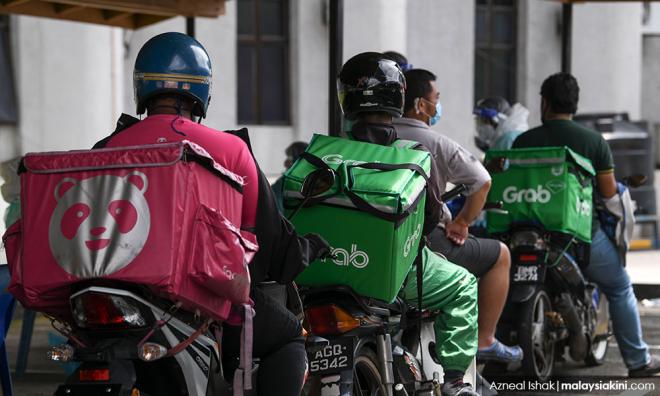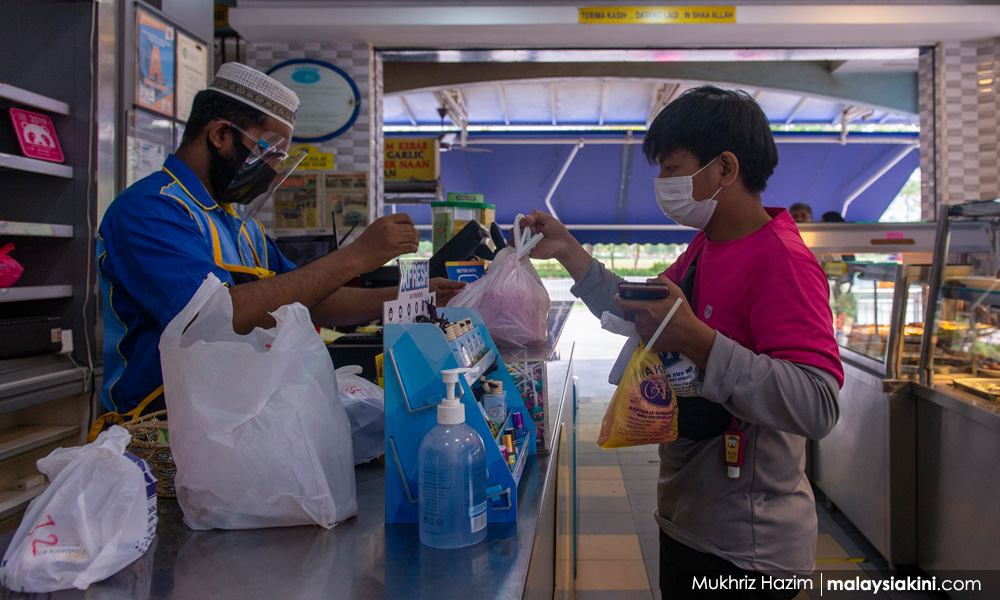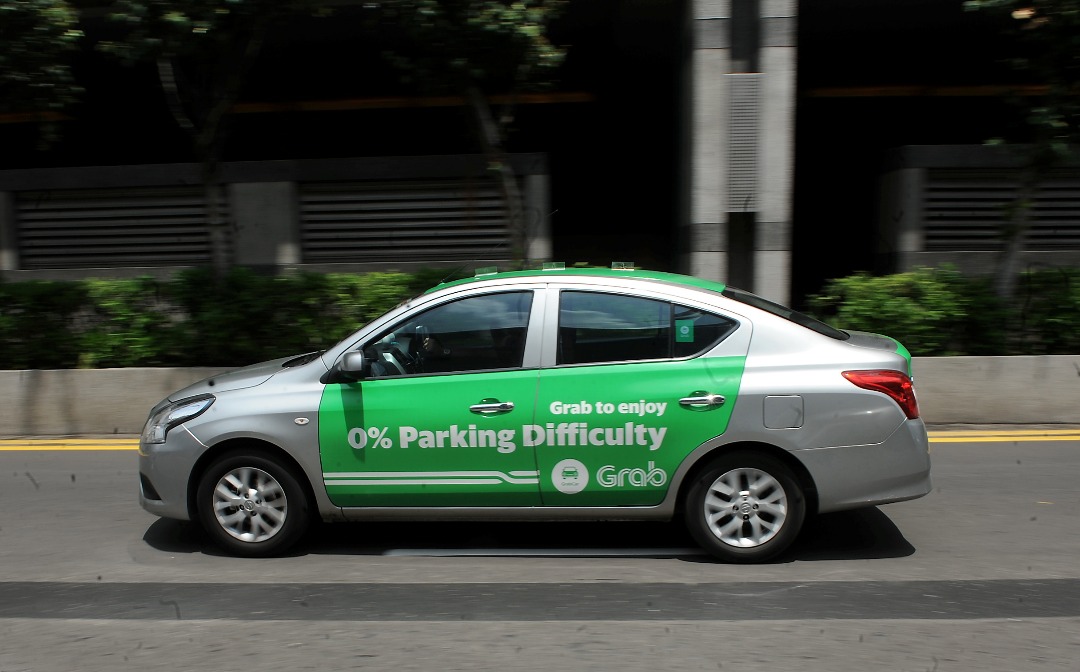
Published in Malaysiakini, Focus Malaysia, Business Today, CodeBlue & Asia News Today, image by Malaysiakini.
Although the administration is trying its best to have every Malaysian vaccinated, e-hailing drivers and delivery riders, who are known as unsung heroes in the service delivery area, were not included in the vaccine priority group.
Based on the guidelines from the Covid-19 Vaccine Supply Access Guarantee Special Committee (JKJAV) on March 1, Phase 1 of vaccination involves 500,000 medical and non-medical frontline personnel and will be completed in April.
To date, Phase 1 of the vaccination comprises two categories:
- Frontliners in contact with Covid-19 test samples, including at private facilities; medical, dental, pharmaceutical and lab officers; as well as paramedics and auxiliary support staff; and
- A large group that is at risk but not directly exposed, including general practitioners, private dentists, complementary medicine practitioners and private laboratory staff. Security personnel, the National Welfare Department, haemodialysis centre operators, teachers with co-morbidities, ministers and elected representatives are non-health frontliners who could receive vaccination during Phase 1.
Despite the vaccination among ministers and elected representatives possibly generating greater public confidence, e-hailing drivers and delivery riders who work long hours and require physical presence to perform their jobs perhaps should be the ones to be vaccinated in advance.
They are known as uncelebrated frontliners who are always exposed to the sun and rain to make ends meet.
After losing their regular jobs due to the Covid-19 pandemic, many became full-time e-hailing drivers or delivery riders. Hence, the statistics of those involved in such services last year will likely become higher than in previous years.
In 2019, there were 466,600 workers involved in the gig sector compared with 559,900 workers in 2018, according to the Department of Statistics.
In addition, local think tank The Centre indicated in its recent findings that gig platforms such as Grab and Foodpanda experienced a surge in demand for delivery services and delivery rider applications since the enforcement of the first movement control order (MCO) in March last year.

The movement restrictions from the MCO and conditional MCO led more people to place orders online. In turn, this has generated higher revenue among the food delivery service providers – showing a growth of 7.3 percent and 14.5 percent in the first quarter (Q1) and second quarter (Q2) of 2020 respectively.
Even though the e-hailing sector recorded a contraction of revenue at 16 percent and 68.8 percent in Q1 and Q2 of last year respectively, it saw the highest rebound in revenue with a 237.8 percent growth in the third quarter when economic activities reopened from June 10 last year.
To fulfil the rising orders from work-from-home customers, some of the e-hailing drivers and delivery riders had to work more than eight hours a day, without having the time to enjoy proper meals. They had to rush from one destination to another to reduce the waiting time among customers, ensuring the food is well-served.
E-hailing drivers and delivery riders are the ones who not only earn a living to keep life going for their family but are also helping to expand the economic chain of traders. The sacrifice they make received attention from Prime Minister Muhyiddin Yassin during his visit to the Grab Drivers Centre in Petaling Jaya at the end of November last year.
An additional 10,000 e-hailing drivers and delivery riders since the first imposition of the MCO implies that now is the time for the government to work closely with 33 e-hailing providers in the country.
By going beyond the auspices of the Science, Technology and Innovation Ministry, Health Ministry and the National Security Council, all e-hailing drivers and delivery riders eventually would receive vaccination soon.
As Grab launched a Southeast Asia region-wide vaccination programme to increase vaccine access and education for all stakeholders on its platform since Feb 4, JKJAV perhaps could consider Indonesia’s approach – collaborating with Grab to initiate drive-through vaccination service centres across Malaysia, where it could prioritise vaccination for almost 500,000 gig workers on the platform in several phases.

As Phase 1 will be completed in April, JKJAV perhaps could arrange 20 percent of the gig sector workers (around 100,000 individuals) to be vaccinated during Phase 1 of vaccination, followed by 40 percent of workers (about 200,000) in Phase 2 and 3 which will begin in April and May respectively.
To ensure all e-hailing drivers and delivery riders are vaccinated, JKJAV should work with all the e-hailing providers to mark and include all of them on their map, especially those in semi-urban areas or rural areas.
When the government provides vaccination for all e-hailing drivers and delivery riders by the year-end, Malaysia would be able to establish a social safety net among the group, driving renewed economic activities in the new normal.
Amanda Yeo is a research analyst at Emir Research, a think tank focused on strategic policy recommendations based on rigorous research.
Diterbitkan di Berita Harian.
BERDASARKAN garis panduan Jawatankuasa Khas Jaminan Akses Bekalan Vaksin COVID-19 (JKJAV) pada 1 Mac lalu, fasa 1 vaksinasi yang akan berakhir April membabitkan 500,000 petugas barisan hadapan perubatan dan bukan perubatan.
Namun, suatu yang menyedihkan apabila pemandu e-hailing dan pengendara penghantaran yang bekerja sepanjang masa dan memerlukan kehadiran fizikal untuk melaksanakan tugas mereka, tidak pula tersenarai kumpulan utama.
Berdasarkan statistik Jabatan Perangkaan Malaysia, 466,600 pekerja terbabit sektor gig pada 2019 berbanding 559,900 pada 2018.
Kajian The Centre, sebuah kumpulan pemikir tempatan, menunjukkan platform ekonomi gig seperti Grab dan Foodpanda menerima lonjakan permintaan dalam perkhidmatan penghantaran serta aplikasi pengendara penghantaran sejak penguatkuasaan Perintah Kawalan Pergerakan (PKP) pada Mac tahun lalu.DISYORKAN UNTUK ANDA
Pelaksanaan PKP dan PKP Bersyarat (PKPB) menyebabkan lebih ramai individu membuat pesanan dalam talian, lantaran itu sektor penyedia khidmat penghantaran makanan mencatatkan pertumbuhan pendapatan 7.3 peratus pada suku pertama, diikuti 14.5 peratus pada suku kedua tahun lalu.
Bagi memenuhi permintaan pelanggan yang kian meningkat khususnya yang bekerja dari rumah, sebilangan pemandu e-hailing dan pengendara penghantaran terpaksa bekerja lebih lapan jam sehari tanpa mempunyai masa untuk menjamu selera.
Mereka bergegas dari satu destinasi ke destinasi lain bagi mengurangkan masa menunggu pelanggan, demi memastikan makanan dihidangkan dengan baik.
Pemandu e-hailing dan pengendara penghantaran bukan sahaja mencari rezeki bagi keluarga mereka, tetapi juga membantu memperluaskan rantaian ekonomi peniaga. Pengorbanan berterusan mereka mendapat perhatian Perdana Menteri, Tan Sri Muhyiddin Yassin, sempena lawatan ke Pusat Pemandu Grab di Petaling Jaya akhir November tahun lalu.
Tambahan 10,000 pemandu e-hailing dan pengendara penghantaran sejak pelaksanaan PKP pertama Mac lalu bererti sekarang adalah masa untuk kerajaan bekerja rapat dengan 33 penyedia perkhidmatan e-hailing di negara ini.
Dengan komitmen Grab dalam meningkatkan akses dan pendidikan vaksin bagi semua pihak berkepentingan dalam platformnya melalui pelancaran program vaksinasi di Asia Tenggara sejak 4 Februari, JKJAV seharusnya mempertimbangkan pendekatan seperti Indonesia, iaitu bekerjasama dengan Grab untuk melaksanakan vaksinasi secara pandu lalu di seluruh Malaysia.
Kaedah ini dapat mengutamakan pemberian vaksin kepada kira-kira 500,000 pekerja gig Malaysia di plat- form itu dalam beberapa fasa.
Memandangkan fasa 1 vaksinasi akan selesai April ini, JKJAV mungkin boleh mengatur 20 peratus pekerja sektor gig (100,000 individu) menerima vaksinasi pada fasa 1, diikuti 40 peratus (200,000 individu) pada fasa 2 dan 3 yang masing-masing bermula April dan Mei.
Demi memastikan semua pemandu e-hailing dan pengendara penghantaran menerima vaksin, JKJAV perlu bekerjasama dengan 33 penyedia perkhidmatan e-hailing di negara ini dengan menyertakan semua pemandu e-hailing dan pengendara penghantaran untuk program vaksinasi terutama di kawasan separa bandar atau luar bandar.
Langkah ini juga akan membantu Malaysia mewujudkan jaringan keselamatan sosial dalam kalangan pemandu e-hailing dan pengendara penghantaran, lantas mendorong kegiatan ekonomi dalam norma baharu ini.
Amanda Yeo merupakan Penganalisis Penyelidik di EMIR Research, sebuah organisasi pemikir bebas yang berfokuskan kepada pencernaan saranan-saranan dasar strategik berteraskan penyelidikan yang terperinci, konsisten dan menyeluruh.

